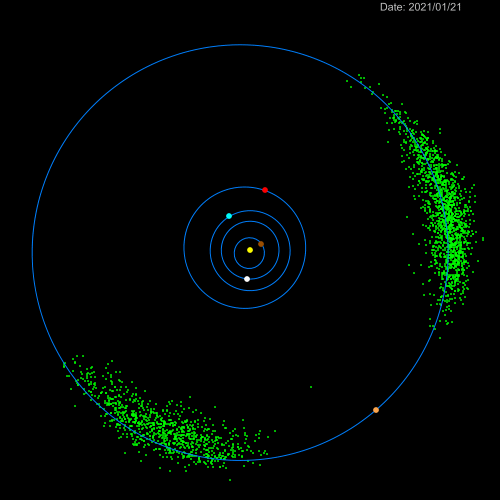[ad_1]
On 30 July, an Air Power C-17 cargo airplane touched down on a runway at NASA’s Kennedy House Heart in Florida. A large delivery container was rolled off the craft. The dear cargo inside, revealed in an Astrotech cleanroom, was examined, and cleared by inspectors.
The Lucy spacecraft had arrived safely on the house heart, readying for its upcoming historic mission. This automobile, designed by the Southwest Analysis Institute, would be the first to go to the Trojan asteroids which accompany Jupiter on its orbit across the Solar.
If the whole lot goes in keeping with plan, an Atlas V 401 rocket will carry the Lucy spacecraft into house, someday between 16 October and eight November.
Lucy, Lucy, Lucy…
Lucy (the spacecraft) was named in honor of Lucy, an early hominid present in Ethiopia in 1974. Lucy (the early hominid) was, in flip, named after the Beatles music, Lucy within the Sky with Diamonds.

Simply as Lucy (the early hominid) offered researchers glimpses into the event of early people, researchers hope for related insights into the historical past of our personal photo voltaic system.
“Over its twelve-year major mission, Lucy will discover a record-breaking variety of asteroids, flying by one principal belt asteroid and 7 Trojan asteroids. Lucy additionally incorporates three Earth-gravity assists to succeed in the Trojan swarms and achieve these focused encounters,” NASA explains.
Tag-a-long Asteroids
The Trojan asteroids of Jupiter are present in two teams, orbiting simply in entrance of, and behind, the King of the Planets. Astronomers conclude these tag-along asteroids are composed of among the earliest materials within the photo voltaic methods. Learning these cosmic third-wheels may reveal secrets and techniques of the early Photo voltaic System.
“The spacecraft will encounter the primary of its eight targets, a principal belt asteroid, in 2025. Lucy will attain the primary of seven Trojan asteroids in 2027 and fly by the ultimate binary pair in 2033. Lucy incorporates three Earth-gravity assists in an epic flight to those superb, record-breaking encounters,” mentioned Dr. Cathy Olkin, Lucy’s deputy principal investigator.

The 46-foot-wide Lucy spacecraft is powered by a pair of huge photo voltaic panels, practically seven meters (24 toes) throughout. These behemoth collectors will permit Lucy to function on solar energy whereas on the orbit of Jupiter — a job which has by no means earlier than been completed.
“The spacecraft is starting its ultimate spherical of testing and pre-launch checks, which embody software program, instrument, powered operate, propulsion propellent load and telecommunication system checks in addition to spacecraft self-tests,” SwRI reviews.
The Lucy mission guarantees a wealth of information for astronomers searching for to know the character of our photo voltaic system.
This text was initially printed on The Cosmic Companion by James Maynard, the founder and writer of The Cosmic Companion. He’s a New England native turned desert rat in Tucson, the place he lives along with his pretty spouse, Nicole, and Max the Cat. You may learn the unique article right here.
[ad_2]
Supply hyperlink